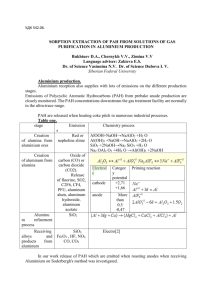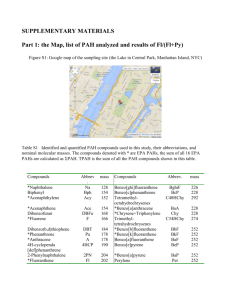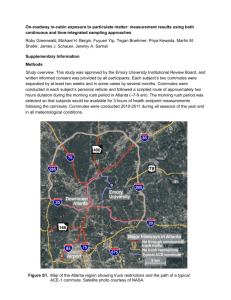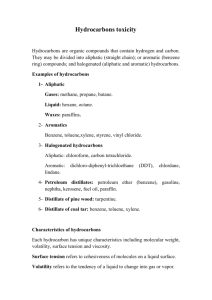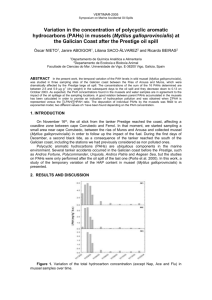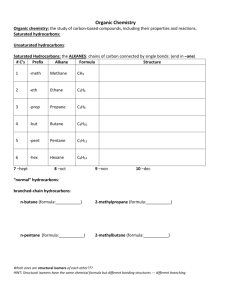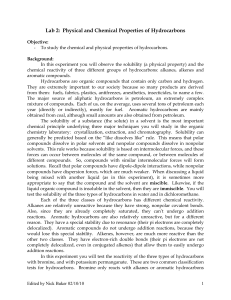HOW TO CHARACTERISE ATMOSPHERIC PARTICULATE MATTER
advertisement
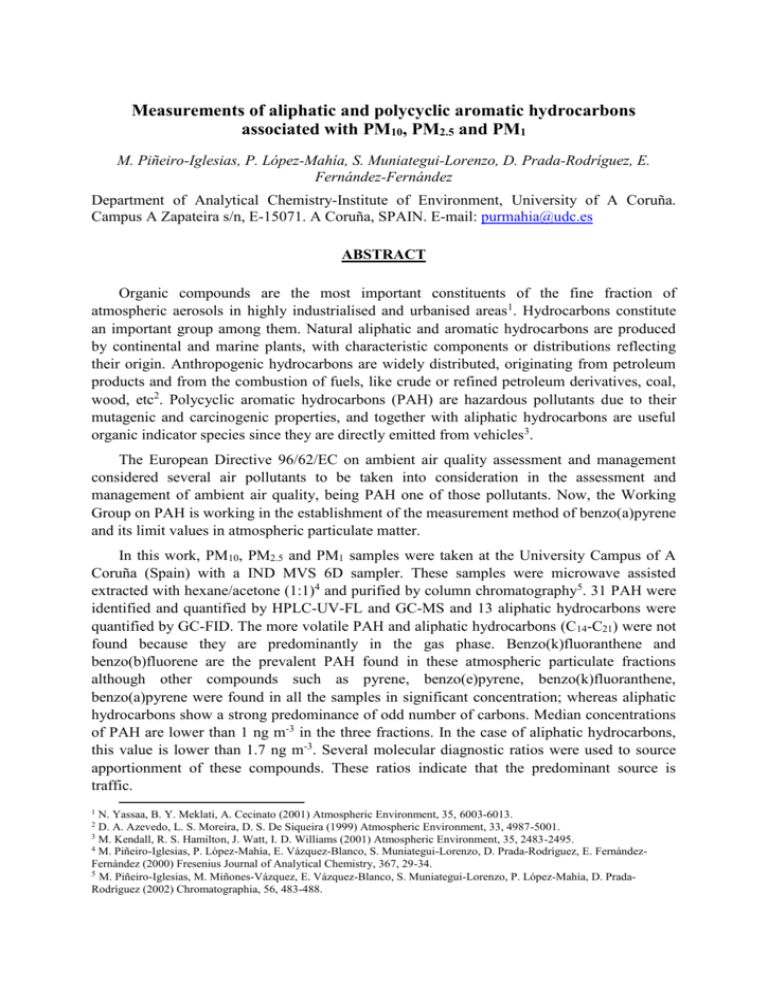
Measurements of aliphatic and polycyclic aromatic hydrocarbons associated with PM10, PM2.5 and PM1 M. Piñeiro-Iglesias, P. López-Mahía, S. Muniategui-Lorenzo, D. Prada-Rodríguez, E. Fernández-Fernández Department of Analytical Chemistry-Institute of Environment, University of A Coruña. Campus A Zapateira s/n, E-15071. A Coruña, SPAIN. E-mail: purmahia@udc.es ABSTRACT Organic compounds are the most important constituents of the fine fraction of atmospheric aerosols in highly industrialised and urbanised areas1. Hydrocarbons constitute an important group among them. Natural aliphatic and aromatic hydrocarbons are produced by continental and marine plants, with characteristic components or distributions reflecting their origin. Anthropogenic hydrocarbons are widely distributed, originating from petroleum products and from the combustion of fuels, like crude or refined petroleum derivatives, coal, wood, etc2. Polycyclic aromatic hydrocarbons (PAH) are hazardous pollutants due to their mutagenic and carcinogenic properties, and together with aliphatic hydrocarbons are useful organic indicator species since they are directly emitted from vehicles3. The European Directive 96/62/EC on ambient air quality assessment and management considered several air pollutants to be taken into consideration in the assessment and management of ambient air quality, being PAH one of those pollutants. Now, the Working Group on PAH is working in the establishment of the measurement method of benzo(a)pyrene and its limit values in atmospheric particulate matter. In this work, PM10, PM2.5 and PM1 samples were taken at the University Campus of A Coruña (Spain) with a IND MVS 6D sampler. These samples were microwave assisted extracted with hexane/acetone (1:1)4 and purified by column chromatography5. 31 PAH were identified and quantified by HPLC-UV-FL and GC-MS and 13 aliphatic hydrocarbons were quantified by GC-FID. The more volatile PAH and aliphatic hydrocarbons (C14-C21) were not found because they are predominantly in the gas phase. Benzo(k)fluoranthene and benzo(b)fluorene are the prevalent PAH found in these atmospheric particulate fractions although other compounds such as pyrene, benzo(e)pyrene, benzo(k)fluoranthene, benzo(a)pyrene were found in all the samples in significant concentration; whereas aliphatic hydrocarbons show a strong predominance of odd number of carbons. Median concentrations of PAH are lower than 1 ng m-3 in the three fractions. In the case of aliphatic hydrocarbons, this value is lower than 1.7 ng m-3. Several molecular diagnostic ratios were used to source apportionment of these compounds. These ratios indicate that the predominant source is traffic. 1 N. Yassaa, B. Y. Meklati, A. Cecinato (2001) Atmospheric Environment, 35, 6003-6013. D. A. Azevedo, L. S. Moreira, D. S. De Siqueira (1999) Atmospheric Environment, 33, 4987-5001. 3 M. Kendall, R. S. Hamilton, J. Watt, I. D. Williams (2001) Atmospheric Environment, 35, 2483-2495. 4 M. Piñeiro-Iglesias, P. López-Mahía, E. Vázquez-Blanco, S. Muniategui-Lorenzo, D. Prada-Rodríguez, E. FernándezFernández (2000) Fresenius Journal of Analytical Chemistry, 367, 29-34. 5 M. Piñeiro-Iglesias, M. Miñones-Vázquez, E. Vázquez-Blanco, S. Muniategui-Lorenzo, P. López-Mahía, D. PradaRodríguez (2002) Chromatographia, 56, 483-488. 2

